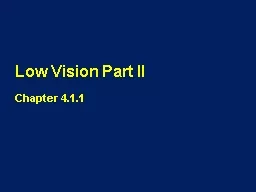

Chapter 411 Overview Now that you have had some experience with using the simulators this presentation provides An introduction to poor acuity blurry central vision Some special considerations regarding vision and the environment ID: 459996
Download Presentation The PPT/PDF document "Low Vision Part II" is the property of its rightful owner. Permission is granted to download and print the materials on this web site for personal, non-commercial use only, and to display it on your personal computer provided you do not modify the materials and that you retain all copyright notices contained in the materials. By downloading content from our website, you accept the terms of this agreement.
Slide1
Low Vision Part II
Chapter 4.1.1Slide2
Overview
Now that you have had some experience with using the simulators, this presentation provides:
An introduction to poor acuity (blurry central vision)
Some special considerations regarding vision and the environment
Implications for SSPs in working with DB people who have poor visionSlide3
POOR ACUITYSlide4
Blurry Vision
Some
DB
people
do
not
have
tunnel
vision.
Macular degeneration and diabetic retinopathy, among other things, cause blindness that impairs central vision making it difficult to see detail.
This makes it difficult to recognize objects and people.
It also makes it difficult to read print.Slide5
Blurry Vision – Poor AcuitySlide6
It’s a picnic benchSlide7
Close Vision
Blurry vision is sometimes called
‘
close vision
’
. This is because when acuity is poor the person will need to stand close to see signing.
Slowing your signing, especially when
fingerspelling
, helps.
Some people with very blurry or close vision do better using tactile signing.Slide8
POOR VISION AND
THE ENVIRONMENTSlide9
Locating...
With poor vision it is difficult to scan to locate objects or people. SSPs help by pointing them out.
If you are showing the DB person an object, get close.
Touch is often very helpful.Slide10
“Yes, that’s it
”Slide11
Edges and Contrast
A DB person who does not usually use a guide or a cane but has poor vision may miss seeing steps or unexpected objects in the way.
An SSP would make sure they notice such dangers.Slide12
Steps
See the edges?Slide13
LIGHT AND COMMUNICATIONSlide14
Lighting
For people with low vision (either tunnel vision or blurry vision), lighting is very important. To make the best use of what lighting is available, consider the following:
Level of light
Glare
Direction of lightSlide15
Dim Lighting
In dim lighting there is lack of color as well as lack of detail. Slide16
Dim Light + Tunnel VisionSlide17
Light, Glare and the SSP
The previous slides showed low or dim light. If you are communicating with a person who has problems with lighting, take time to move into a place and position where the lighting is optimal.Slide18
Glare
Snow and bright sun on the water can create glare that we are all familiar with.
Our eyes, however, are not as sensitive as those of people with poor vision.
Windows, white tablecloths, white shirt collars, and sleeve cuffs are common offenders.
As an SSP, be aware of lighting in all its forms.Slide19
GlareSlide20
Glare, cont.
Overhead light (including from the sun) often creates glare as does light in the visual field.
Most people with low vision wear caps or hats with bills, or sunglasses that block glare from the sun or overhead light (even when indoors).Slide21Slide22
Direction of Light
Back Lit Front Lit Slide23
Light & Direction
The light should not be shining in your eyes, of course, but it is especially important that the light not be shining in the eyes of the DB person.
The woman in the next slide is having to look into the light – not good.Slide24Slide25
Adjustment Time
It also takes the person with poor vision longer to adjust to changes in light, especially going from bright to dim light, or vice versa.
This means when you enter a building, you will need to pause a few minutes for the DB person to adjust to the new lighting situation.Slide26
SSPs and Clothes
Wear plain, contrasting shirts and blouses (tops) so your signing is clear.
White clothes make it easy to spot the person but difficult to read their signs.
Dark colors absorb the light and prevent glare.
Remove shiny jewelry, especially earringsSlide27
Bad Example
Here
the pale signer is wearing white. The sun is behind him. Add tunnel vision and it becomes very difficult to follow his signs.Slide28
Much BetterSlide29
Clothes with Good Contrast – Low GlareSlide30
PRINTSlide31
Applying the Same Principles
The
same rules (by now very familiar to you) apply to print.
Good
contrast (including bold print
)
Low
glareSlide32
Computer Print
You will notice that all the power points in this curriculum have a dark background (not white) and light lettering. This makes for optimum contrast and minimum glare.
For paper, buff color makes a good choice since it is low-glare.
Felt-tip pens are also bolder and hence easier to see. A pencil is not good at all.Slide33
Simulation
Try the blurry vision or poor acuity simulators.
As you begin work as an SSP it is beneficial to use simulators from time to time.
Do this with your colleagues. Give yourselves specific assignments or tasks. Discuss your experiences with each other. You will gain new insights.Slide34
Conclusion
When a person has poor vision, a little change in the environment or from day to day may make a big difference. Even a headache can put someone
‘
over the edge’.
Over time, the vision of people who are deaf-blind will typically continue to change.
Be alert to such changes.Slide35
Conclusion, cont.
Practice consciously so that these adjustments to your communicating will become natural to you and you will automatically choose appropriate clothing, where to position yourself, as well as notice what is most helpful and efficient while respecting the autonomy of the DB person.